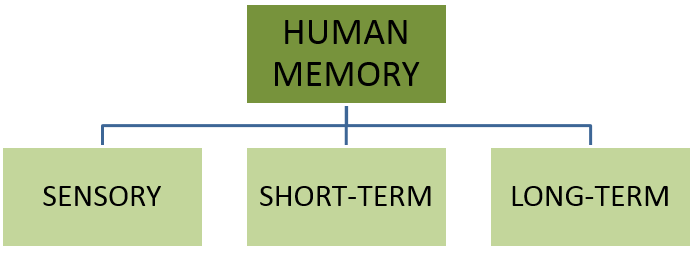How to Design eLearning for Different Memories? 9 Elements to Look For!

Your learners struggle to remember what was carefully taught in an online course. How often do you fret over this? Well, if this is a challenge your organization is facing, consider this question. Did your eLearning course include design elements that simulate different memory techniques to enhance learners’ ability to remember? In case your answer is no, it’s time you know why designing eLearning courses pertaining to different memory types is imperative for longer retention.
9 Elements to Incorporate While Designing eLearning for Different Memory Types
Sensory Memory
- Ensuring consistency
- Avoiding too much consistency
- Avoiding meaningless variability
Short-Term Memory
- Chunking information
- Utilizing auditory stimuli
- Encouraging application of existing knowledge
Long-Term Memory
- Making repetition the key
- Integrating storytelling
- Using scenarios and simulations
Memory Is the Foundation
Before plunging into eLearning design elements, it’s essential to know how learners learn and remember. How does all the training information get into the brain on any given day? And how will they find and retrieve it when they need it?
“Successful learning involves encoding and retrieval- memory in and memory out.” (Julie Dirksen, Design For How People Learn.) Remembering is considered the first essential step, but your learners should be able to retrieve, combine, manipulate, and innovate with the information they acquired. (Dirksen)
However, employees come across a lot of information, and it’s really not possible to pay attention or remember all of it. Fortunately, studies show a series of triggers that allow your learners to parse this information. What are these?
Different Levels of Human Memory
Sensory Memory – The First Level
The first level of memory is the Sensory memory. Everything your learners perceive and sense is captured momentarily by this first filter. For instance, if you are working in office, you are likely to hear the hum of an AC or the noise of people typing. But an individual only notices them when somebody calls attention toward them.
Sensory memory isn’t a problem when it comes to eLearning design, except when it transcends to habituation. When habituated, we tend to stop noticing those activities, for instance the annoying buzz of the generator you have been hearing since long. But, when things are unpredictable, it resists habituation.
How Does it Impact eLearning Design?
Ensuring Consistency
To ease the learning process, consistency is a useful tool. For instance, if the layout of each slide in a course is similar, your learners will get used to it. They need not spare mental energy to orient themselves to the layout over and over again. Instead, it allows them to pay more attention to the learning content.
Avoiding Too Much Consistency
If there’s too much consistency, it might lead to habituation in learners. Hence, it’s important to utilize varying teaching methods and ways of presenting the learning content. For instance, if the feedback in an eLearning course is of the same nature (let’s say, Good Job!), chances are learners will move forward without paying attention. To avoid this, offering reasons as to why the answer is correct or incorrect can be one point of differentiation.
Avoiding Meaningless Variability
While variation is useful to hold learners’ attention, meaningless differences can put them off. For instance, if the feedback pop-up is designed to randomly appear at different parts of the screen, it might annoy or disorient learners as opposed to intriguing them. A better way to do so would be providing feedback with interesting, relevant elements such as a video clip.
Short-Term Memory – The Short-lived Memory
When the sensory memory succeeds in attracting learners’ attention it penetrates into their short-term memory. Also known as the working memory, though this memory is short-lived and has limited capacity, learners use it more often throughout the day. However, this memory gets discarded once its purpose has been served. For instance, the Wi-Fi password at a hotel.
This brings me to the factors that will influence retention in short-term memory:
- If it is unusual
- If it is of a familiar format
- If it is important for the learner
How Does it Impact eLearning Design?
Chunking Information
Content chunking in digital learning involves breaking down content into smaller parts, and organizing and grouping them together. This strategy has been proved effective when it comes to reducing learners’ cognitive load.
Additionally, when similar ideas or information are presented together, learners are able to place the information in memory slots or shelves. This in turn will expand the capacity of the short-term memory of learners.
Utilizing Auditory Stimuli
According to Shiffrin and Atkinson (1971), the short-term memory can thrive on auditory stimuli. If your learners hear the ideas and concepts in audio repeatedly, they can acoustically encode the learning content, thereby transcending to the long-term memory.
Hence, to appeal the short-term memory, your eLearning course can include background music, narratives, and audio presentations to foster retention and better information retrieval.
Encouraging Application of Existing Knowledge
When learners are encouraged to utilize their existing knowledge, it allows them to reduce the amount of knowledge decay. Much like the old saying, “If you don’t use it, you lose it,” which fits well for short-term memory.
This implies if learners are not given an opportunity to recall and repeat key information, they might forget it by the time course completes. To counter this, include assessments at the end of a learning point – scenarios, simulations – learning activities that require recall.
Long-Term Memory – The Memory for Retrieval
This is what every organization aims for when they impart training to their employees – making information reach long-term memory. Long-term memory is stored in the brain just as in a closet – a place where one can find something easily when needed.
Although it is debatable if long-term means lifetime, this relatively has a longer existence, where you want your eLearning course to be. Long-term memory allows learners to retain and recall concepts, even outside the virtual learning environment. It can be quite challenging to find ways to process the gained information in a way that it remains accessible and fresh. However, designing different eLearning solutions that caters to long-term memory is a useful tool.
How Does it Impact eLearning Design?
Making Repetition the Key
Just as signals between the neurons in the brain get stronger at higher frequency, eLearning course design should be such that it allows for repetition of memory. This reinforces a memory trace as well as the likelihood of retrieving the information for later use.
For instance, putting forth the eLearning course’s goals and objectives throughout the course or even summarizing each learning unit. You can also include digital learning assets such as infographics, videos etc. to reinforce the key takeaways, in periodic intervals.
Integrating Storytelling
Following an emotional approach helps in engaging learners better. It provides learners content they can relate to. Additionally, learners are more likely to retain information when it is connected to an emotion or a personal experience.
For instance, incorporate stories in your eLearning course that are relatable, which will initiate automatic connection of the semantic memories (facts) with their episodic memories (personal experiences). This enables learners to strike an emotional chord with the subject matter and store it in their long-term memory.
Making Use of Scenarios and Simulations
Simulations and scenarios hitch on immersing learners in eLearning content, taking active retrieval of information a notch higher. It helps your learners build meaningful connections between the information they have stored in their long-term memory and its real-life implications. Additionally, it is essential to develop activities and exercises that emulate real-life challenges or fit into the context of how they will apply this information when they go outside the digital classroom.
For instance, if your learners have to deal with handling machinery, it’s sensible to include scenarios in the eLearning course that will test them on the steps and precautions involved in the activity. Needless to say, doing so will encourage learners to connect that knowledge to that specific process – making it easier for them to recall in future.
Keeping these design considerations in place for your eLearning courses leads to a more effective and engaging learning experience. This lets learners harness different memories to their full potential without overwhelming them.
The human brain and its ability to perform complex and difficult tasks have helped learning evolve and thrive. Engage the brain and you will engage your learners, allowing them to continue to learn, evolve, grow and change in new and exciting ways. Here’s a free eBook on “Instructional Design Strategies to Design Engaging eLearning Courses,” you can download to know more about engaging your learners in eLearning. This eBook will give you insights on popular instructional design strategies, how to choose the right one, and much more!






